A selection of the best recipes for pickled peas for the winter without sterilization: cooking secrets from experienced housewives
In winter, many housewives prepare nutritious and tasty salads with the addition of green peas. Most often, store-bought canned food is used for this. But you can make such seams for the winter yourself! They will be much tastier than store-bought ones, but they will be cooked with soul and quality. Recipes for such preparations are extremely simple, especially if they do not involve sterilization.
If you care about the health of your family, and enjoyed a good harvest of legumes in the summer, we offer several recipes for pickled peas for the winter without sterilization.
Selection and preparation of peas
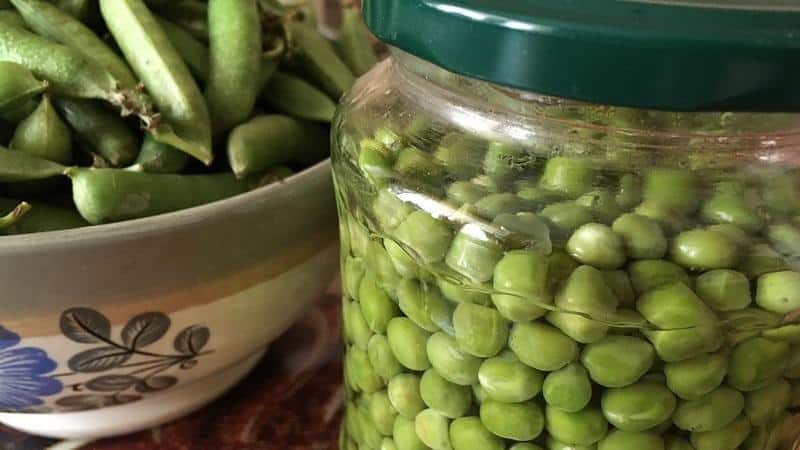
To ensure a high-quality result, it is important to choose the right peas. For canning, you need “brain” peas - just ripened. Usually it reaches this condition on the eighth day from the beginning of flowering. You can check the suitability of a pea by trying to crush it with two fingers - it should give in easily. Using fully ripe or overripe peas is also acceptable, but in this case the brine may be cloudy and the taste may be starchy.
Preparing peas for canning is simple - you just need to wash them thoroughly. It is better to start canning immediately on the day of collection, otherwise the legumes will lose most of their nutrients.
Canning without sterilization
Canning green peas without resorting to sterilization is very convenient. All you have to do is boil the peas until tender and pour in the boiling marinade.The only limitation with this method of preparation: the marinade must contain vinegar or citric acid - natural preservatives that ensure long-term storage.
Attention! Such preparations are stored in the refrigerator or in the basement, that is, in a cool place.
A simple recipe “Just like in the store”
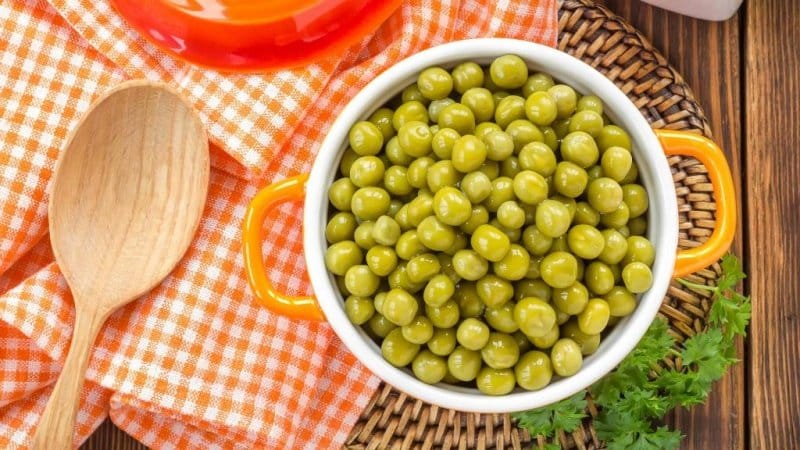
This recipe calls for 9% vinegar. It is simple; even housewives without experience can quickly handle it. The final product tastes like store-bought canned goods.
We will need:
- peas – 700 g;
- water – 1 l;
- salt – 40 g;
- sugar – 15 g;
- vinegar – 100 ml.
Preparation:
- Fill the prepared peas with cold water and place on low heat. After boiling, cook for about 20 minutes.
- Place the peas in the jars, leaving about one and a half centimeters to the edge.
- Prepare the marinade. Add salt, sugar and vinegar to the water (you can use the leftovers from cooking peas). Place on the fire and bring to a boil.
- Pour boiling marinade over peas in jars.
- Close with lids and turn upside down. Cover with a towel and leave to cool.
With citric acid
The following recipe involves the use of citric acid. There are enough ingredients for about three half-liter jars.
Ingredients:
- peas - any quantity, optimally - 700 g;
- water – 1 l;
- salt – 3 tsp;
- sugar – 3 tbsp. l.;
- citric acid – 1 tsp.
Preparation:
- Add sugar and salt to boiling water. Add the peas (the marinade should completely cover the peas).
- Bring to a boil again and cook for about 15 minutes over medium heat.
- At the end of cooking, add citric acid.
- Using a slotted spoon, transfer the peas to the jars.
- Pour the hot marinade over the peas.
- Close with lids and turn upside down.Cover with a towel or blanket until completely cool.
With cucumbers
Olivier salad lovers will appreciate this original recipe. This wrapping is very practical: by closing the peas and cucumbers for the winter, you will make it easier for yourself to prepare the salad for the New Year.
Ingredients:
- cucumbers – 0.6-0.8 kg;
- green peas – 400 g;
- water – 500 ml;
- salt – 2 tbsp. l.;
- sugar – 4 tbsp. l.;
- vinegar 9% - 3 tbsp. l.;
- garlic – 2 large cloves;
- a set of greens for preservation (horseradish, ripe dill).
Preparation:
- Fill the prepared peas with cold water and place on low heat. Cook for about 15 minutes after boiling. It is important not to overcook the peas - overcooked peas will be unsuitable for salad.
- While the peas are cooking, prepare the jars. We put greens in them for preservation. You can use any greens that you like to add to cucumbers.
- We crush the garlic with the wide side of the knife and also put it in the jars.
- Place the cucumbers vertically in a row and sprinkle with peas. You can shake the jars periodically to ensure the peas fit compactly.
- Pour boiling water into the jars. Cover with clean lids and leave for 5 minutes.
- Drain the water. We boil it again and repeat the fifth step again.
- Drain the water again.
- Now let's prepare the marinade. Add sugar, salt and vinegar to the water drained from the cans. Bring to a boil again. Pour into jars.
- Close the lids tightly and turn the jars upside down. Wrap it in something warm and leave it to cool.
Salted peas recipe
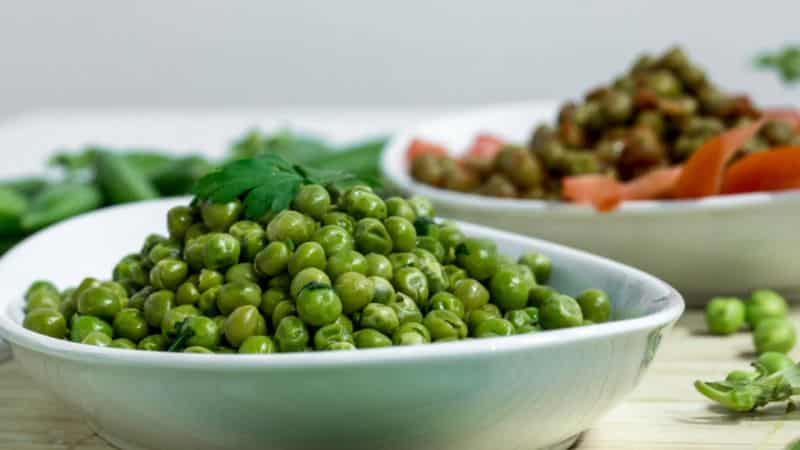
This recipe is especially for salty lovers. It is as simple as possible, consisting of only two ingredients. It does not contain vinegar. These peas can be successfully added to soups instead of salt.
Ingredients:
- green peas – 2 kg;
- salt – 600 g;
Preparation:
- Boil the prepared peas in lightly salted water for about 10 minutes.
- Place the peas in a colander.
- Mix with salt and place in jars.
- Pour boiling water under the neck. Close the lids tightly.
- Turn it upside down and wrap it in a towel. Leave to cool.
Pickled pea pods
Pickled pea pods are an excellent alternative to black olives. These pods look impressive when served with meat or fish dishes. They taste different from regular pickled peas. Five-day-old pods are suitable for preparation. The peas are already ripe, but the pods themselves are still soft.
Ingredients:
- young green pea pods;
- water – 1 l;
- sugar – 40 g;
- vinegar 9% – 3 tbsp. l.;
- citric acid - on the tip of a knife;
- black peppercorns and cloves - 2 pcs. into each jar.
Preparation:
- Soak the pods in cold water for two hours. Blanch them in boiling water with citric acid for one or two minutes.
- Place the pods in jars, add peppercorns and cloves.
- Prepare the marinade: bring water, sugar and vinegar to a boil.
- Pour the marinade into jars and roll up the lids.
- Turn the jars upside down and cover them with a blanket. Leave to cool.
Recipe "Savory"
This recipe uses bay leaves, which gives the final product a unique flavor. Dishes using such peas will have a pleasant aroma.
Ingredients:
- peas – 400g;
- vinegar 9% – 1 tsp;
- salt – 1 tsp;
- water – 150 ml;
- bay leaf – 2 pcs.
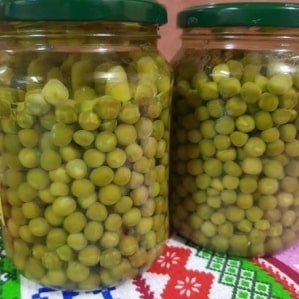 Preparation:
Preparation:
- Pour the prepared legumes with cold water and cook over low heat for 10-15 minutes.
- Place the peas in a jar.
- Cook the marinade: add salt, vinegar and bay leaf to the water. Bring to a boil.
- Pour the boiling marinade over the peas in the jars. Close with lids.
- Turn the jars upside down and wrap them in a warm towel or blanket. Leave to cool.
Preservation in an autoclave
And this recipe is for those who are lucky enough to have an autoclave. An autoclave is a modern device that allows you to preserve food while preserving as many useful substances as possible. With this method, the taste of the product does not change. This is especially important when preparing soups and salads. You can also cook beans and corn this way.
Ingredients:
- peas – 900 g;
- water – 900 ml;
- sugar – 20 g;
- salt – 20 g.
Preparation:
- Pour the prepared peas with water and place on low heat.
- After boiling, add salt and sugar, cook for half an hour over low heat.
- Using a slotted spoon, transfer the beans to the jars.
- Strain the remaining cooking liquid. The easiest way to do this is through gauze folded in several layers.
- Pour the strained broth into jars.
- Place in autoclave for 30 minutes.
Secrets of successful canning
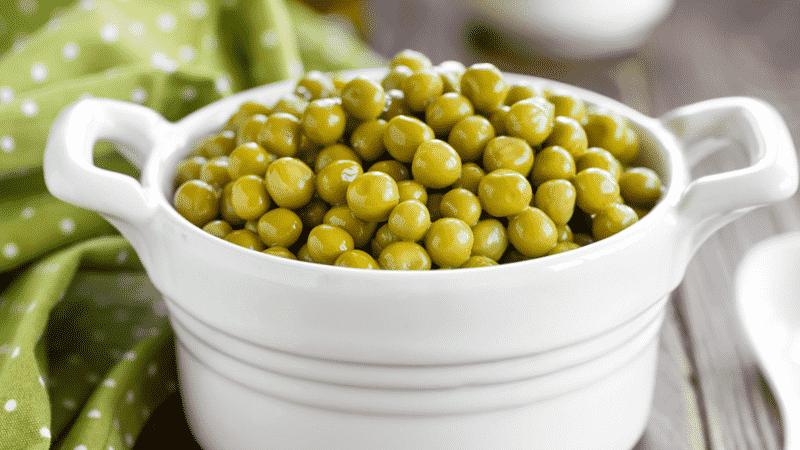
Canning peas is not difficult. Even a beginner can handle most recipes. For an even greater chance of success, there are three secrets. Thanks to them, it will be possible to preserve this vegetable perfectly:
- Secret No. 1 Prepare the product correctly. There's no need to rush. First, thoroughly wash the pods, then take out the peas themselves. Wash well again with cool water. You can use a colander.
- Secret No. 2. When preparing a recipe, you must add all ingredients strictly according to proportions. Of course, if you already have experience in such canning and have developed your own taste preferences, you can change the proportions. But for the first time it is better to stick to the recipe.
- Secret No. 3.Only whole peas should be used. It's worth checking them twice before marinating. The first time is in preparation for cooking. It is better to remove crushed peas. The second time, we take a closer look at the cooked peas. If some of them are boiled, it is better not to send them to jars. There is a lot of starch in peas, the deformed shell of the pea will let the starch into the brine, and the liquid in the jars will become cloudy.
There is no acid in legumes that would allow canned food to be stored all winter without adding preservatives. This is why many recipes contain vinegar or citric acid. If you decide to cook without these ingredients, you need to take into account that such canned food will be stored for no longer than two to three months. And definitely in a cool place.
To make seaming with peas even more useful, you can use spring water instead of regular water. Such water is considered “living”; its structure is not clogged with negative information, unlike ordinary tap water. Dishes based on this water will definitely turn out delicious!
After preservation, do not rush to take the jars to the basement or cellar. Keep them in the refrigerator for several days. In the first days, experienced housewives advise monitoring whether the brine has become cloudy. If this does not happen, you can safely send the jars to a permanent storage location.
Read also:
How to prepare pickled hot peppers for the winter without sterilization.
The most delicious recipes for pickled tomatoes for the winter in jars.
Conclusion
Pickling green peas for the winter is a simple process. You can involve children in this activity; they will be happy to help sort out the sweet peas.And it’s okay that the amount of product will noticeably decrease after this, but everyone will have fun and tasty.
Peas are an amazing product, delicious both fresh and cooked. It will be an excellent side dish for meat dishes. You can make a puree from it. And of course, it is perfect for preparing various salads.
Now you know the most interesting recipes for preparing this product for the winter at home. Use them and follow the secret recommendations when preparing, then the result will definitely please you.